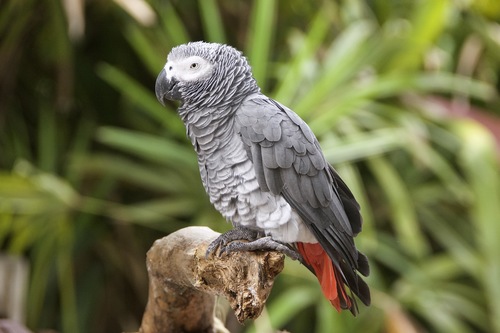
Grey Parrot
The Grey Parrot (*Psittacus erithacus*), also known as the African Grey Parrot, is a highly intelligent bird species native to equatorial Africa. Renowned for its exceptional cognitive abilities, particularly its capacity for mimicking human speech, the Grey Parrot plays a significant ecological role as a seed disperser in its rainforest habitat. It holds cultural significance in various African communities and is a popular, albeit demanding, companion animal globally, raising important conservation concerns due to its popularity in the pet trade.
30-35 cm
Length
46-52 cm
Wingspan
Endangered
Conservation Status
Distribution
Primarily found in equatorial Africa, including countries like Ghana, Ivory Coast, Congo, and Angola. There are isolated populations in southeastern Ivory Coast and southwestern Ghana. They have also been introduced to other areas through the pet trade, establishing feral populations in some locations.
Lifespan
In the wild, typically 20-30 years. In captivity, they can live much longer, potentially 50-60 years or more with proper care.
Grey Parrot's Habitat
Habitat Types
Primary lowland rainforests, Secondary forests, Forest edges, Mangrove forests, Savannas with gallery forests, Cultivated areas (occasionally)
Climate Zones
Tropical
Adaptations
Strong beaks adapted for cracking hard nuts and seeds. Zygodactyl feet (two toes pointing forward, two backward) for efficient climbing and manipulation of food. Highly developed cognitive abilities likely aid in navigating complex forest environments and remembering food sources.
Variations
Two main subspecies are generally recognized: *Psittacus erithacus erithacus* (Congo Grey Parrot) and *Psittacus erithacus timneh* (Timneh Grey Parrot). The Timneh Grey Parrot is smaller, darker, and has a maroon tail, whereas the Congo Grey Parrot is larger, lighter grey, and has a bright red tail.
Appearance
Breeding Plumage
No significant difference between breeding and non-breeding plumage.
Seasonal Feather Changes
No significant seasonal variations.
Sex Based Plumage Differences
Very subtle; males may have slightly flatter heads and narrower necks, but this is not a reliable indicator. DNA sexing is often used.
Notable Features
Predominantly grey plumage with varying shades., Bright red tail feathers (Congo Grey Parrot)., Maroon tail feathers (Timneh Grey Parrot)., Bare white facial patch around the eyes., Powerful, hooked beak., Dark grey to black beak.
Diet and Feeding
Primary Foods
Fruits, Nuts, Seeds, Berries, Vegetation, Palm nuts (particularly important)
Foraging Behavior
Primarily forages in trees, often in flocks. They use their strong beaks to crack open hard nuts and seeds. They may also descend to the ground to feed on fallen fruits or clay licks (possibly for mineral supplementation or detoxification).
Specializations
Strong beak and specialized tongue for manipulating and extracting seeds from fruits and nuts.
Seasonal Diet Variations
Diet may shift depending on the availability of fruits and nuts throughout the year. During periods of scarcity, they may rely more on seeds and vegetation.
Behavior
Social Structure
Highly social; typically found in flocks, which can range from small groups to large congregations, especially at roosting sites.
Communication
Wide range of vocalizations, including whistles, screams, clicks, and squawks., Exceptional mimicry abilities, capable of learning and repeating human speech and other sounds., Body language, such as feather fluffing, head bobbing, and wing displays.
Migration
Generally non-migratory, but may make local movements in response to food availability.
Territorial or Group Behaviors
May defend nesting sites, but are generally not highly territorial outside of the breeding season. Flocking behavior provides protection from predators and facilitates foraging.
Conservation
Threats
Habitat loss and fragmentation due to deforestation (logging, agriculture)., Trapping for the international pet trade (historically the most significant threat)., Persecution as agricultural pests in some areas., Hunting for food and traditional medicine.
Protection Programs
CITES Appendix I listing (prohibits international commercial trade)., Various conservation organizations working on habitat protection and anti-poaching efforts., Community-based conservation initiatives in some areas.
Local National Laws
Protected under national laws in many range countries.
Population Trend
Decreasing
Population Estimates
Difficult to assess precisely, but significant declines have been documented across much of its range. Estimates suggest a decline of 50-79% over three generations (62 years).
Interesting Facts
Grey Parrots are among the most intelligent bird species.
They have demonstrated cognitive abilities comparable to those of a 4-6 year old human child in some tasks, including understanding concepts like same/different, bigger/smaller, and even zero.
They can develop extensive vocabularies.
Some individuals have been documented to learn hundreds of words and phrases, and even use them in context.
The two subspecies, Congo and Timneh, were once considered separate species.
Recent genetic and morphological studies support their classification as subspecies, although some debate remains.
They are long-lived birds.
This makes them a significant commitment as pets, requiring specialized care and attention for many decades.
Wild Grey Parrots play an important role in seed dispersal.
By consuming fruits and nuts, they help to regenerate forests.
Faqs about Grey Parrot
Are Grey Parrots good pets?
Grey Parrots can be rewarding companions for experienced bird owners, but they are very demanding. They require significant mental stimulation, social interaction, a specialized diet, and a large, enriched environment. Potential owners should thoroughly research their needs before acquiring one.
Can Grey Parrots really talk?
Yes, Grey Parrots are renowned for their ability to mimic human speech and other sounds. However, not all individuals will talk, and the extent of their vocabulary varies.
What is the difference between a Congo Grey Parrot and a Timneh Grey Parrot?
The Congo Grey Parrot is larger, has a bright red tail, and a black beak. The Timneh Grey Parrot is smaller, has a maroon tail, and a horn-colored upper mandible.
Why are Grey Parrots endangered?
The primary threats are habitat loss and trapping for the pet trade. Although international trade is now largely prohibited, illegal trapping continues.
How can I help Grey Parrot conservation?
Support organizations working to protect their habitat and combat illegal wildlife trade. Avoid purchasing wild-caught parrots, and consider supporting captive breeding programs or adopting a rescued parrot if you are prepared to provide a suitable home.
Copyright @ Nature Style Limited. All Rights Reserved.
 English
English